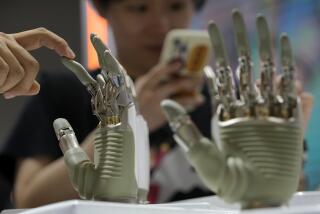Industrial Revolution
- Share via
Concerns over working conditions, child labor and industrial harm to the environment fueled recent protests at the World Trade Organization Summit in Seattle, but these are issues that have roots in the Industrial Revolution of 200 years ago. The Industrial Age, which began in England in the mid-1700s, moved workers from farms to factories as technological advances such as the water loom, steam engine and mass production transformed the way people work. Discover how the Industrial Revolution changed people’s lives and livelihoods, and how steps such as labor reform were needed to manage its impact through the direct links on the Times Launch Point Web site: https://fold6.site/launchpoint.
Level 1
Samuel Slater: Father of the American Industrial Revolution: How did the Industrial Revolution come to the United States when England did not want anyone with technical knowledge to leave the country? Through Samuel Slater, an Englishman who in 1793 constructed the first successful textile mill in Pawtucket, R.I. Read the story of his life and view photos of this historic mill and Slatersville, the first industrial village.
https://www.geocities.com/~woon_heritage/slater.htm
The Lowell Project: Find out about the American Industrial Revolution through a peek into the lives of the Lowell factory “mill girls,” who worked 14-hour days. Read about inventors such as Eli Whitney and James Hargreaves, and learn about the advantages and disadvantages of the assembly line versus cottage industries.
https://hammer.ne.mediaone.net/lowell/lowell.html
Factories Change the Way Americans Work: Discover the impact of the invention of the steam engine and the water loom, and how factories changed the way people worked. View video clips that show how the development of interchangeable parts speeded up production and how unions were formed to improve working conditions.
https://157.182.12.132/omdp/marge/html/student/st_l2.htm
Level 2
An American Industrial Revolution Unit: Why is the Industrial Age considered a revolution? Explore this dynamic period through commentaries and photos that describe the development of inventions, the changes in working conditions, the rise of big business monopolies and the birth of unions.
https://www.coe.uh.edu/archive/sstudies/sstudies_lessons/ssles5/index.html
Spotlight Biography: Inventors: Discover the stories behind how the steamboat, cotton gin, telegraph and telephone were invented during the flurry of innovation that marked the Industrial Revolution.
Http://educate.si.edu/spotlight/inventors1.html
Industrial Revolution: Women’s History: The Industrial Revolution created jobs for women in textile factories and coal mines. Find out how these jobs offered the prospect of independent wages and a better standard of living but more often resulted in hardships--long hours and difficult working conditions.
https://home.earthlink.net/~womenwhist/lesson7.html
Level 3
The Age of Industry: Famous inventors, impoverished workers, socially conscious writers and artists--these are some of the people who contributed to this time of great change. Learn about the history behind different industries, the contributions of key individuals and what daily life was like through this well-organized and extensive collection of resources.
https://history.evansville.net/industry.html
British History: Child Labour 1700-1900--The Sparticus Encyclopedia: How would you like to work from 5 in the morning to 9 at night for a penny an hour? Read accounts by former child laborers, child labor supporters and factory reformers, view archival photos and illustrations from the period, and find out about the labor laws that were finally passed to protect workers.
https://www.spartacus.schoolnet.co.uk/IRchild.main.htm
The Industrial Revolution Reference History: The Industrial Revolution can be seen as a series of revolutions that began with innovations in textiles and steam engines from 1712 to 1830, and later included important developments in electricity and chemicals from 1875 to 1905. Explore this site’s many resources on inventors and inventions, as well as articles that explore the causes and effects of these revolutions.
https://history1700s.about.com/education/history1700s/library/
mresource/blindustry.htm
EXPLORER’S QUEST
The answer to this Internet quiz can be found in the sites at right.
Why did Eli Whitney’s idea of interchangeable parts revolutionize production?
CLUE: See An American Industrial Revolution Unit
Find What You Need to Know: Have a project on California history? Need help doing a math problem? Launch Point now covers more than 100 topics for getting your schoolwork done. Go to https://fold6.site/launchpoint/ for the full list of subjects and direct links to the best Internet sites.
Answer to last week’s Quest: “Nunavit” means “our land” in Inuktitut, the Inuit language.
Launch Point is produced by the UC Irvine department of education, which reviews each site for appropriateness and quality. Even so, parents should supervise their children’s use of the Internet. This column was designed by Nicholas Klemek, Henee Lim, Gabriela Reyes and Anna Manring.
More to Read
Inside the business of entertainment
The Wide Shot brings you news, analysis and insights on everything from streaming wars to production — and what it all means for the future.
You may occasionally receive promotional content from the Los Angeles Times.










